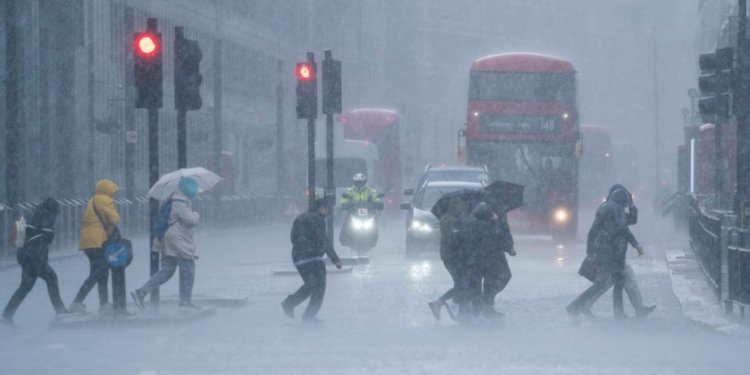Unfortunately, climate activists live in the fantasy world of averages and averages of averages, not reality. In their mythical universe temperatures can be stabilised and power consumption projected, all based on those averages. Their ideology has been allowed to drive Government policy for years and the result has been a misguided reliance on the vagaries and unreliability of solar and wind power.
Nick Cater in the Australian and a senior research fellow at the Menzies Research Centre is looking into his own nation’s gloomy energy future, and finds that Britain’s energy policy is a cautionary tale:
Britain’s last coal-fired power station closed at the end of September, throwing households to the mercy of the weather. Turbines and cooling towers at Ratcliffe-on-Soar in Nottinghamshire are about to be demolished to make way for a zero-carbon technology and energy hub. Sadly, Britain’s green activists have no plans to follow coal into retirement. The curse, or joy, of being a fighter for progressive causes is that your work is never done.
“The priority now is to move away from gas as well,” Friends of the Earth’s Tony Bosworth told the Guardian. Friends of the Earth, like every other international green activist group, also opposes nuclear power. This begs the question: How will Britain keep the lights on without the three sources capable of providing baseload power? Bosworth’s clownish answer is posted on FoE’s website. “We have an abundance of natural resources like wind and solar,” he says. “They’ll go on forever, and we won’t be reliant on expensive gas and oil.”
Climate activists are average people, driven by average calculations of average temperatures on average days projected into the future. On the other hand, people who run electricity systems focus on actual weather since much of the theoretical capacity at their disposal depends on it. So while activists were celebrating their symbolic victory over coal last autumn, energy operators were looking nervously at the long-range weather forecast and the prospect that the weakness of the Polar Vortex might continue into winter. Sure enough, it has, with a characteristic high-pressure system sitting stubbornly over Greenland blocking the Atlantic Gulf Stream winds that make the U.K. winter less intolerable.
Last week, an Arctic front hit with a vengeance, reducing temperatures to as low as minus-20 and burying parts of England in snow. The diminishing number of Brits who could afford to do so turned up the heating. Many are readers of the Guardian, 85% of whom are in the top socio-economic group. The less affluent readers of the Daily Express were offered helpful tips using a 20m roll of aluminium foil selling for 99p ($1.97) at Aldi. Lining the wall behind the radiator apparently reflects more heat inside.
Demand for electricity rose to a high of 50GW on Wednesday, well above the 44.4GW peak predicted by the National Energy System Operator in its winter outlook, published just as 2GW of coal generation capacity from Ratcliffe-on-Soar was vanishing forever. Meanwhile, wind speeds fell, as they often do in winter when the Polar Vortex turns limp. In theory, NESO has 30GW of wind at its disposal. On Wednesday, as electricity demand went through the roof, only 3GW was available. Solar? Forget it, for this is Britain, after all, at the lowest point in the winter solstice.
The only way out has been to buy in gas:
Between Thursday and Saturday, 55% of electricity came from gas and just 11% from wind and solar. The output from Britain’s nuclear reactors hummed along at 4.7GW, but at 10% of total output it only touches the sides of Britain’s baseload thirst.
But of course, far from energy security, Britain is now at the mercy of international markets while spurning its own reserves:
Britain’s gas problems have only just begun. Buying gas on the international spot-market is expensive and supply chains are vulnerable. A 140,000-cubic-metre LNG carrier would supply less than half the daily demand. The tragedy is the U.K. has abundant reserves of gas, if the green warriors would only call off their campaign. On top of substantial reserves beneath the North Sea, there are at least a quadrillion cubic feet of onshore shale gas that’s hardly been touched. If a tenth of that proves economically viable, Britain would have enough gas to last 50 years.
The driving force behind this looming catastrophe, says Cater, is the green movement:
A Supreme Court decision in June known as the Finch ruling obliges planning officials to factor in the emissions of consumers, not just the emissions used in extraction and transportation. This has set the scene for a judicial activists’ picnic. Greenpeace and Uplift have applied for a judicial review of the Rosebank and Jackdaw North Sea developments sending them back to the planning stage.
It’s a flashback to the nightmare of Britain in the 1970s when a miners strike put the country on a three-day week and the BBC shut down at 10.30pm to save electricity. This time, it’s not the union movement that’s usurping the role of an elected government but the green movement, aided and abetted by the courts.
Australia is headed down the same route and is now about to have to start importing gas:
It has taken many years of patient activism, weak-kneed government, pusillanimous journalism and dumbed-down policy discussion to get us to this point.
Governments don’t stay in power if they make people cold and poor, but that’s a lesson Britain’s recent and present administrations don’t seem to have learned. One day they will, but it will take years, perhaps decades “to reverse the momentum and establish a reliable energy network”, warns Cater.
Worth reading in full.
Stop Press: Sir Jim Ratcliffe has warned that Britain’s multibillion-pound chemicals industry is facing “extinction” because of soaring energy costs and Net Zero.











To join in with the discussion please make a donation to The Daily Sceptic.
Profanity and abuse will be removed and may lead to a permanent ban.
“Governments don’t stay in power if they make people cold and poor”. They do if there is no coherent opposition to vote for.
And even if they don’t stay in power and get replaced, the next lot just carry on in the same way, so it makes no difference.
And they are rewarded with gongs for failure.
Which confirms what I keep repeating on here – our governments are NOT running the country.
Pitchforks.
Petrol bombs while we still have access to it.
All the petrol pumps have been damaged by climate zealots.
Pointing out the costs and suffering won’t put an end to insane climate policies.
The policies stem from the idea that burning fossil fuels leads to climate catastrophe and destruction.
In most peoples’ minds, a bit of suffering is better than catastrophe and destruction.
Years and years of brainwashing need to be undone.
But that isn’t going to happen without telling everyone that the whole CO2 climate catastrophe story is a giant hoax.
Too many people who try to argue against climate policy on the basis of the unacceptable costs don’t dare to challenge the broader narrative and that’s a big problem.
I think this is true for the Guardian readers I know, but I also talk to quite a few people much more grounded in reality and I am sure they would be more than happy to forget about the climate crisis if their bills went down.
People are saying that “the whole CO2 climate catastrophe story is a giant hoax” but they do not try to prove it. Probably they do not know enough to be able to.
The UN and WEF will be delighted that their planned destruction of the UK …. at the hands of the British Establishment and puppeticians is going so well.
Only a small percentage of the Earth’s surface has direct temperature reading instruments of varying accuracy and from which these averages of averages are calculated.
The result is numbers, not data.
Net-zero common sense for decades. And all because the earth has supposedly warmed 0.8 deg C since 1860 when records began at the low point after a little ice age.
To physicists, that’s an increase of 0.3% from 288 to 288.8 degrees Kelvin. Meanwhile the difference in average temperature between London and Manchester is 1.2 deg C. Go figure.
A simpleton’s yarn debunked over a decade ago by a Nobel Physics Laureate…
https://mediatheque.lindau-nobel.org/recordings/31259/the-strange-case-of-global-warming-2012
“…In this talk I will explain why I became concerned about the climate, and terrified by the one-sided propaganda in the media, In particular I am worried about all the money wasted on alternate energies, when so many children in the world go hungry to bed.”
Twelve years on, the Climate Theatre of the Absurd just runs and runs.
Thanks for the link.
Climate activists are average people
No, I think most of us would consider them below average retards if there answer to a lack of wind generation is just to build more of it. 1 + 1 still only equals 1 when it is the percentage of output from your windmills.
Energy, supply and demand.
The article covers comprehensively the supply end, or lack of it, but leaves out the zooming demand. According to the (fake) statistics, the population of Greater London in 2024 was 9,748,000, 1% more than 2023. Nevertheless, going by measurements of water consumption and sewage production, the real figure is close to 12m. And this is the curious thing. The NetZeroist fanatics also support enthusiastically open borders, ignoring the fact that increasing population levels lead to huge greenhouse gas emissions.
Friends of the Earth’s Tony Bosworth said, “We have an abundance of natural resources like wind and solar,” he says. “They’ll go on forever, and we won’t be reliant on expensive gas and oil.”
Bosworth ought to be sent, along with the Just Stop Oil filth who have just desecrated the grave of Charles Darwin, to Texas, to be instructed by the Texans about what happened to their wind & solar during the terrible “Polar Vortex” Blizzards in 2021. The wind turbines froze solid, the solar panels were covered with snow, and the people froze to death.
“The Texas Winter Storm And Power Outages Killed Hundreds More People Than The State Says”
“A BuzzFeed News analysis shows the catastrophic failure of Texas’s power grid in February killed hundreds of medically vulnerable people.”
“The true number of people killed by the disastrous winter storm and power outages that devastated Texas in February is likely four or five times what the state has acknowledged so far. A BuzzFeed News data analysis reveals the hidden scale of a catastrophe that trapped millions of people in freezing darkness, cut off access to running water, and overwhelmed emergency services for days.”
“The state’s tally currently stands at 151 deaths. But by looking at how many more people died during and immediately after the storm than would have been expected — an established method that has been used to count the full toll of other disasters — we estimate that 700 people were killed by the storm during the week with the worst power outages.”
“This astonishing toll exposes the full consequence of officials’ neglect in preventing the power grid’s collapse despite repeated warnings of its vulnerability to cold weather, as well as the state’s failure to reckon with the magnitude of the crisis that followed.”
Texas’s Winter Storm Killed Hundreds More Than Reported
Until the mainstream media stop repeating the net zero lies, it will remain difficult to get the honest message such as this article, through.